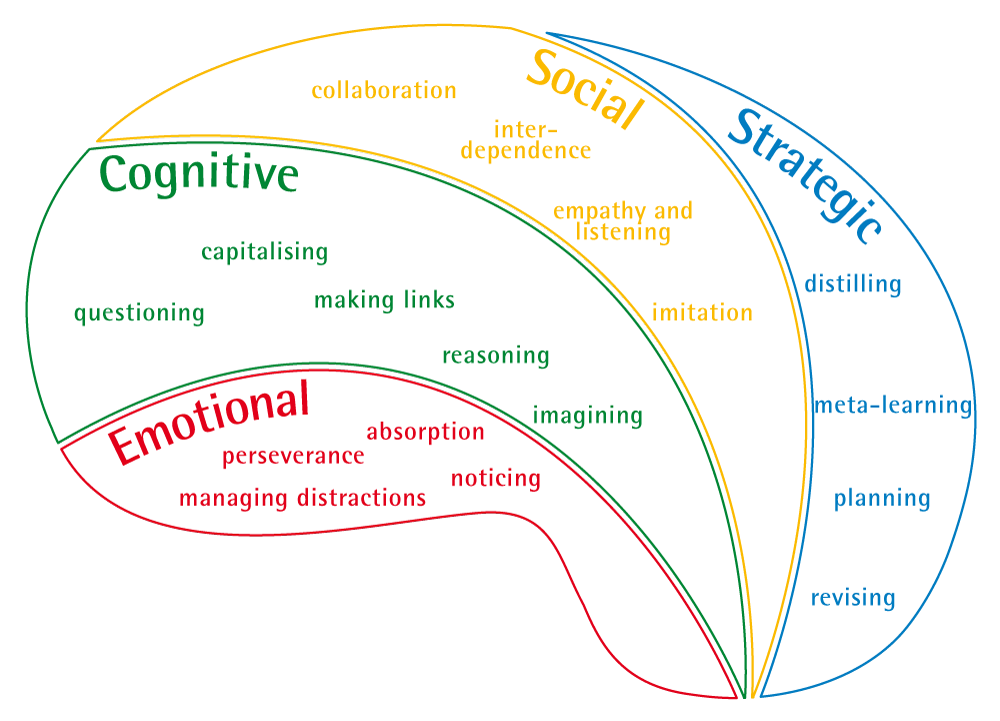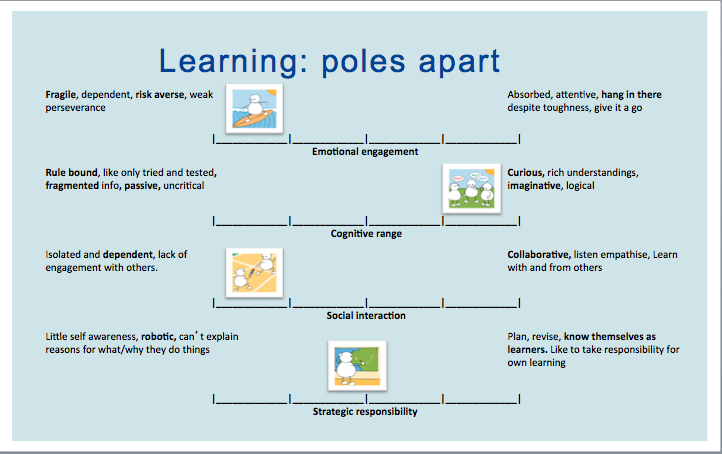If parents were to enquire whether their child had become more perseverant, or imaginative, or independent over their time in the school, what would you be able to say? How would you respond beyond, hopefully, “yes”, or some bland statement about “sticking at things for longer”? How would you know? What would you know?
A changing world
‘Students throughout the world need now to reach higher levels of achievement, not only to find fulfilling work but also to empower themselves to thrive in an increasingly complex world’
– Dylan Wiliam
Of course the job of any school is to prepare youngsters for their future lives. Students need the exam results AND a set of generic skills and attitudes to deal with complexity; learning dispositions such as curiosity, inquisitiveness, experimentation, reflectiveness and sociability.
For years now research in the learning sciences has shown that learning is itself a learnable craft; that we can all get better at learning. This means that schools, teachers and indeed parents can enable young people to develop as better, more effective learners.
More recently, research has shown not only that it is possible but that it is desirable, that such habits matter more than examination results in life beyond school. The Myth of Achievement Tests: The GED and the Role of Character in American Life, James Heckmen.
What is Building Learning Power?
Learning conscious students
To build learning power is to enable students to gain good results AND become learners who are consciously aware of developing learning behaviours such as perseverance, self-control, attentiveness, resilience to adversity, openness to experience, empathy, tolerance to diverse options. A wealth of high-value learning habits.
Through learning-centred cultures
Getting this to happen is about creating a culture in classrooms – and the school more widely – that systematically cultivates such habits and attitudes. It involves teachers becoming more precise and forensic about learning behaviours and attitudes, and shifting school cultures to becoming more learning-friendly.
We may of course think we do this but how often do we, as teachers, give students a problem and say, “work together and come back with your answer”? The assumption is that the students know how to work effectively in teams, but what appears to be a simple everyday social task has many facets that need to be learned and practised: can they share their ideas effectively, build on the ideas of others, clarify the task, agree on their goals, listen empathetically, change their minds and direction if necessary, stay focussed, monitor their progress and so forth? And all before they have applied the problem-solving skills needed to find the solution. Making the journey to learning-centred cultures is a gradual, sometimes difficult, but hugely worthwhile process of culture change by the school and habit change by teachers.
The learning-friendly classroom culture
Learning becomes a shared responsibility, with students being given more responsibility for their own learning. A language for learning is gradually introduced helping students to become conscious of using their learning behaviours. Using and extending this language adds breadth and depth to how teachers and learners talk about, understand and improve learning. Reflecting on and reviewing learning are built into classroom routines; learning activities are designed to stretch and challenge learning behaviours and content acquisition. The underlying learning values become visible through what is recognised, praised, displayed.
Because learning-centred teachers have a particularly rich conception of learning and the habits that underpin it, they are able to design nudges and activities that target quite specific aspects of learning behaviours.
Learning-centred teachers
Like it or not, all teachers are in the habit forming business. The way in which pupils perform and behave is influenced by how teachers talk about learning, what they notice and praise and how they guide learning. Learning enquiries in many schools have shown that even under intense pressure to attain high levels of conventional achievement, small experimental steps can make teachers feel more confident about amending the delivery of the syllabus to make room for students to use a wider selection of their learning behaviours.
A learning-centred school
To be successful with this approach, schools need to see Building Learning Power as:
- a whole-school culture change
- a long term innovation, not a quick fix initiative to raise results
- putting high-value psychological characteristics at the heart of education
- a sustained dialogue amongst staff to focus Professional Development
- playing a bigger game of education
A learning framework
The framework of learning dispositions, originally conceived and researched by Emeritus Professor Guy Claxton reveals learning as a complex process that is not simply about having a good memory. It includes how we feel (emotions), how we think (cognition), how we learn with others (social), and how we manage the process of learning (meta-cognitive).
It is this framework that offers the start of a learning language. Having a language that captures the richness of learning is used to understand and discuss the learning process, helping teachers and students to uncover learning as a visible process that can improve.
But it’s the building that counts
The whole point of building powerful learners is to do just that, to build students’ learning behaviours. The diagram below – outlines possible starts and ends of a learning journey: the building of students’ emotional, cognitive, social and meta-cognitive learning habits. From the reluctant learner on the left and the learning powered learner on the right lies a progression that can be mapped. A recent innovation in Building Learning Power has been to develop such progression maps. It has helped schools to understand the more worthwhile long-term development of powerful learners.
School mission statements often include words like ‘independent’, ‘confident’ and ‘adaptable’ as skills they aim to impart to their students. The language of Learning Power is what helps schools to turn such rhetoric into reality.
Online learning and support
In response to increasing demand and shrinking school budgets Building Learning Power has recently moved online. Schools across the world can now access a staged training programme that chunks and orders this complex innovation into do-able bite sized sessions, modules and programmes to implement over time
The blended learning programmes are a careful blend of:
- Online learning sessions….that faithfully disseminate the researched content;
- Professional Learning Team sessions……actioned by the school to provide sustained, meaningful support for teachers;
- Trying things out in the classroom……because ‘learning by doing’ is integral to the development of expertise which can only be developed if teachers have ample opportunity for practice, reflection, and adjustment.
This trio of learning opportunities work together to help teachers replace long-standing habituated practices with more effective ones.
BLP is administered by The Learning Organisation in Bristol, UK (Buildinglearningpower.com)



Comments are closed.